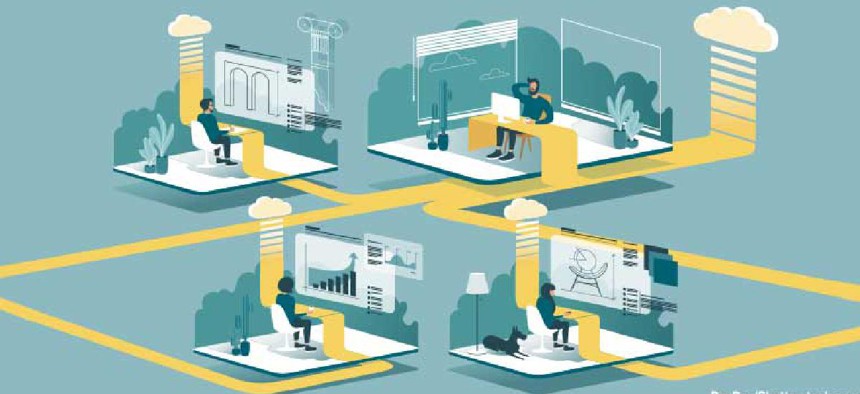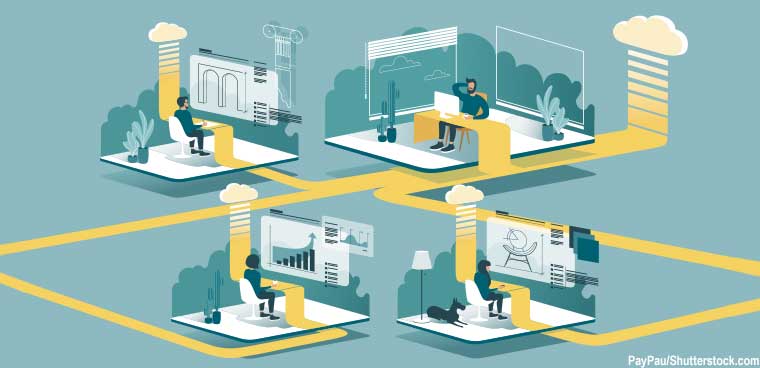OPM official: No going back to pre-COVID status quo

The Office of Personnel Management wants to use upcoming guidance on telework to offer a new vision for federal work, an agency official said Wednesday.

The COVID-19 pandemic declared just over a year ago forced a surge toward telework for government agencies. As the emergency starts to recede and vaccines become more widely available, the question of how federal work will look post-pandemic remains.
"Are we turning back the clock?" asked Rob Shriver, the Associate Director of Employee Services at the Office of Personnel Management.
From OPM's point of view, the answer is no.
OPM is working on guidance about how agencies can pursue remote and telework going forward, Shriver said at an FCW teleworking event on Wednesday.
Before the pandemic, the proportion of feds eligible to telework had largely been holding steady, even as the number of feds teleworking regularly was increasing, according to data Shriver shared from a forthcoming OPM report on 2019 teleworking levels.
At the Department of Housing and Urban Development, the jump in daily telework participation from pre- to post- pandemic was a whopping 90%, according to data from the forthcoming 2020 Federal Employee Viewpoint Survey, said Priscilla Clark, the Deputy Chief Human Capital Officer at the Department of Housing and Urban Development.
In the process, the pandemic has forced many agencies to confront a longstanding cultural hesitancy to working from home by proving that it is possible for many feds, said several workshop participants.
OPM is working on guidance about the future of work as the personnel office looks to "promote a different vision of work in the federal government going forward," Shriver said.
The office is "feeling the pressure" to get policy guidance to agencies on telework and remote work, pay administration and performance management, he said. "We're pushing hard to make sure we have an initial round of guidance out soon."
Already, government officials say that they learned valuable lessons during the pandemic.
Managers haven't been able to oversee their subordinates by literally checking in on their teams anymore, said Shannon Meehan, the acting director of the Executive Services Division at the National Aeronautics and Space Administration. Working from home has required "focusing on trust and establishing a culture that facilitates teams and individuals to deliver the work without being managed or assessed every single second," she said.
They've also seen the potential benefits of remote and telework.
NASA started a pilot "Work from Anywhere" program in 2014, and that flexibility has been useful in attracting new workers, said Shannon. Agency-wide teleworking days also made the agency ready to pivot to remote and teleworking postures when the pandemic hit.
Being able to offer a remote-first work environment is a type of benefit the government can offer, even as other benefits like pay lag behind the private sector, said Elizabeth Ayer, the Director of the 18F Human Services Portfolio.
OPM intends to give agencies flexibility to continue teleworking as they see fit. They're hearing "loud and clear" from stakeholders that a one-size-fits -all won't work here, Shriver said.
"There continues to be an interest in maintaining these flexibilities and making sure that OPM policy facilitates that rather than impedes it," he said. They are currently reviewing teleworking flexibilities and how they might work in the future.
The office will also have to answer questions that've cropped up as a result.
Physically separating the worker from their workplace has created questions for locality pay. It's not clear, for example, how an employee living in a higher-paying locality area but working for an office based in a lower-paying locality should be compensated, said Shriver.
"This system was designed with the assumption that people would be coming into the office," he said. "Telework has kind of been shoehorned into it."
The personnel office is also going to address new gray areas in management as agencies work through what the increased flexibility afforded workers during the pandemic means for the future.
Managers will need training on how to handle long-term hybrid, remote and telework situations, and OPM has also been collaborating with the Chief Human Capital Officers Council and academics to compile teleworking best practices to distribute to agencies, he said.
Another sticky question OPM will have to work through is guidance for vaccine administration in the workforce as vaccines become universally available and reluctance on the part of some individual employees to get vaccinated may become an issue for the workforce at large.
Either way, there's no interest in returning to February 2020 footing," said Shriver. There's a sense among chief human capital officers that "the future is here," Clark said.
NEXT STORY: What's at stake with Biden's Pentagon vacancies?



